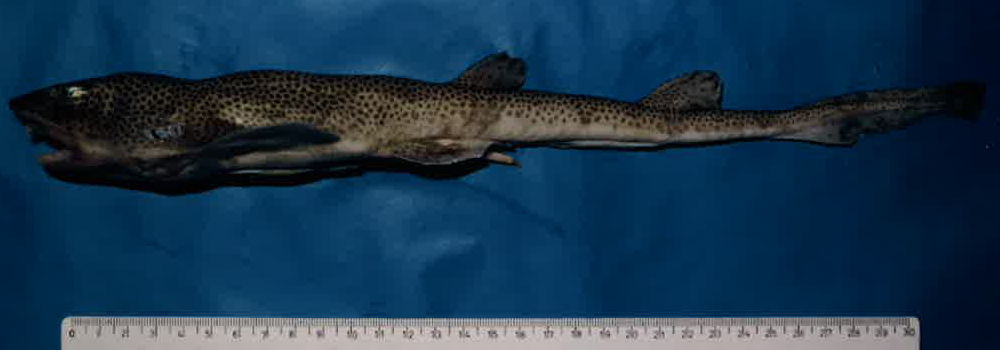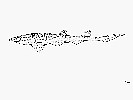Holohalaelurus punctatus
(Gilchrist, 1914)
African spotted catshark
Classification: Elasmobranchii Carcharhiniformes Pentanchidae
Reference of the original description
Description of three new south African fishes. Marine biological report. Union of South Africa, Province of the Cape of Good Hope, 2(VII): 128–131
Description of three new south African fishes. Marine biological report. Union of South Africa, Province of the Cape of Good Hope, 2(VII): 128–131
Synonyms / new combinations and misspellings
Halaelurus punctatus, Holohalaelurus polystigma, Scyliorhinus (Halaelurus) polystigma, Scylliorhinus punctatus
Halaelurus punctatus, Holohalaelurus polystigma, Scyliorhinus (Halaelurus) polystigma, Scylliorhinus punctatus
Types
Holohalaelurus punctatus
Neotype: SAIAB: 6128
Scyliorhinus (Halaelurus) polystigma
Holotype: BMNH: 1921.3.1.1
Holohalaelurus punctatus
Neotype: SAIAB: 6128
Scyliorhinus (Halaelurus) polystigma
Holotype: BMNH: 1921.3.1.1
Description :
Citation: Holohalaelurus punctatus (Gilchrist, 1914): In: Database of modern sharks, rays and chimaeras, www.shark-references.com, World Wide Web electronic publication, Version 04/2024
Please send your images of "Holohalaelurus punctatus" to info@shark-references.com

Holohalaelurus punctatus (Gilchrist, 1914), male, adult, off Madagascar © Jacques Herman, Beigem (Grimbergen), Belgique,

Holohalaelurus punctatus (Gilchrist, 1914), male, adult, off Madagascar © Jacques Herman, Beigem (Grimbergen), Belgique,
Common names
 Pejegato moteado,
Pejegato moteado,  Holbiche à gorge tachetée,
Holbiche à gorge tachetée,  African spotted catshark,
African spotted catshark,  Punctate dogfish,
Punctate dogfish,  Spotted catshark,
Spotted catshark,  Spotted dogfish,
Spotted dogfish,  White-spotted Izak,
White-spotted Izak,  Pata-roxa africana
Pata-roxa africana
 Pejegato moteado,
Pejegato moteado,  Holbiche à gorge tachetée,
Holbiche à gorge tachetée,  African spotted catshark,
African spotted catshark,  Punctate dogfish,
Punctate dogfish,  Spotted catshark,
Spotted catshark,  Spotted dogfish,
Spotted dogfish,  White-spotted Izak,
White-spotted Izak,  Pata-roxa africana
Pata-roxa africana
Short Description
A broad-headed, dwarf catshark with small dark brown spots closely set on a yellow-brown or orange-brown background; small black pores on underside of head and body; no labial furrows [536].
A broad-headed, dwarf catshark with small dark brown spots closely set on a yellow-brown or orange-brown background; small black pores on underside of head and body; no labial furrows [536].
Distribution
Western Indian Ocean: endemic to the subtropical and tropical waters of southwestern Indian Ocean, southern Mozambique, off Natal, South Africa and off Madagascar (Ref. 75585). Status of threat: a common catch in bottom trawls in Natal and southern Mozambique, yet, despite recent biodiversity trawl surveys in that region, not a single specimen has been collected from this area since 1972. ORI data sheets confirm that specimens collected between 1964 and 1972 were apparently abundant, particularly off Mozambique in May 1969, and off Durban in June 1971. The only specimens of this species that have been collected since this date have been those from Madagascar in the late 1980?s and early 1990?s (Ref. 75585). Source: www.gbif.org
Western Indian Ocean: endemic to the subtropical and tropical waters of southwestern Indian Ocean, southern Mozambique, off Natal, South Africa and off Madagascar (Ref. 75585). Status of threat: a common catch in bottom trawls in Natal and southern Mozambique, yet, despite recent biodiversity trawl surveys in that region, not a single specimen has been collected from this area since 1972. ORI data sheets confirm that specimens collected between 1964 and 1972 were apparently abundant, particularly off Mozambique in May 1969, and off Durban in June 1971. The only specimens of this species that have been collected since this date have been those from Madagascar in the late 1980?s and early 1990?s (Ref. 75585). Source: www.gbif.org
Human uses
fisheries: of no interest
fisheries: of no interest
Biology
Oviparous, with one egg-case laid per oviduct at a time. Embryos feed solely on yolk [733]. Partial sexual segregation is manifested by greater number of males than females off Natal but not off southern Mozambique. Found on the uppermost continental slopes. Feeds on small fishes, crustaceans, and cephalopods.
Oviparous, with one egg-case laid per oviduct at a time. Embryos feed solely on yolk [733]. Partial sexual segregation is manifested by greater number of males than females off Natal but not off southern Mozambique. Found on the uppermost continental slopes. Feeds on small fishes, crustaceans, and cephalopods.
Remarks
shark-references Species-ID=2943;
shark-references Species-ID=2943;

















